Exploring 10kt Gold Engagement Rings: A Complete Guide
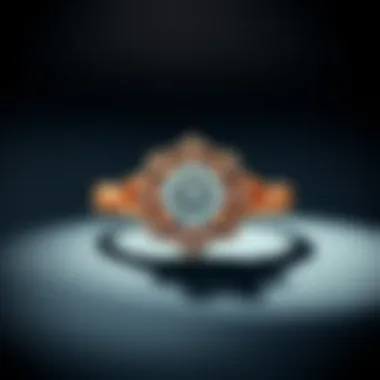

Intro
When it comes to choosing an engagement ring, many people gravitate toward gold for its timeless appeal and inherent value. Among the various karat options available, 10kt gold stands out due to its unique blend of durability and affordability. This specific alloy is composed of 41.67% gold, combined with metals like copper and silver, which enhance its sturdiness while still retaining a rich color and shine.
In the following sections, we will dive into the fascinating world of 10kt gold engagement rings. We will explore not just what makes this metal a popular choice, but also how gemstones elevate the aesthetic even further. The harmony of gold and gems creates a twofold excitement that captures attention and hearts alike.
As we journey through this guide, it’s essential to consider various aspects surrounding 10kt gold engagement rings:
- Gemstone Overview: A look at the various gemstones commonly incorporated in these rings, detailing their appearance and characteristics.
- Design Choices: Discussing the meaning behind different styles and settings.
- Pricing Factors: The cost variables that buyers might need to consider.
- Cultural Significance: How customs surrounding engagement rings evolve and what they signify.
- Maintenance Tips: Offering practical advice on how to care for your ring.
By weaving these elements together, our objective is to impart clear, valuable insights for anyone who finds themselves on the precipice of purchasing an engagement ring. Let's unfold the nuances surrounding these exquisite pieces of jewelry starting with a deep dive into the gemstones that can ideally complement the beauty of 10kt gold.
Understanding Gold Alloys
Gold alloy is a term that encapsulates the various blends of gold with other metals, each bringing distinct characteristics. This blending process is crucial when discussing engagement rings forged from 10kt gold. Understanding these alloys ensures that consumers make informed decisions, particularly when investing in something as significant as an engagement ring.
Gold itself, in its pure form, is relatively soft and malleable. A ring crafted from pure gold would easily scratch and lose its shape over time. Therefore, other metals are added to enhance durability, provide varied colors, and sometimes to adjust the price point. These factors can significantly affect both the aesthetic and practical aspects of a piece of jewelry. An awareness of alloy compositions allows potential buyers to appreciate the craftsmanship behind their chosen ring and make well-rounded choices.
Composition of Gold Alloys
The composition of gold alloys can vary significantly. For instance, in 10kt gold, there is 41.7% gold mixed with metals like copper, silver, or zinc. This composition not only adds strength but can also influence the color.
- Gold Content: Higher gold content usually denotes a richer hue but softer texture. 10kt gold provides a sweet spot, exhibiting a delicate golden essence while boasting resilience.
- Other Metals: Copper is popular in rose gold, lending a pinkish tint, while silver creates a more classic white appearance in white gold.
- Versatility and Customization: As tastes evolve, the capability to tweak these compositions allows consumers to personalize their rings further, blending their preferences with their partner's style.
Understanding these make-ups is key for potential buyers. It allows one to appreciate the balance between beauty and durability that these combinations offer.
Differences Between Gold Purity Levels
When discussing gold purity levels, it’s essential to grasp how these measurements can influence the quality, durability, and price of the jewelry. Here’s a breakdown of some common purity levels:
- 24kt Gold: This is the purest form of gold and consists of 99.9% gold. It's vibrant but lacks the strength needed for everyday wear.
- 22kt Gold: Contains 91.7% gold, offering sturdiness, yet remains relatively soft compared to lower purity levels.
- 18kt Gold: Comprises 75% gold, providing a mix of strength and elegance, making it a popular choice for fine jewelry.
- 14kt Gold: Has 58.3% gold, balancing affordability and quality.
- 10kt Gold: As mentioned previously, consists of 41.7% gold, guaranteeing durability for daily wear while also being budget-friendly.
The choice of purity level often reflects the wearer's lifestyle. Those involved in hands-on activities may favor 10kt or 14kt gold for its practicality, whereas someone looking for a more luxurious piece might lean towards 18kt or even 22kt.
Thus, understanding these differences allows consumers to evaluate how the purity level aligns with both their budget and the intended use of the engagement ring.
The Significance of 10kt Gold
When it comes to engagement rings, the type of gold can make a significant difference in both aesthetics and practicality. Among various choices, 10kt gold stands out as an intriguing option. It strikes a balance between beauty and durability, making it a popular choice for many couples. But what exactly makes it significant? For starters, 10kt gold is composed of 41.7% pure gold, mixed with other metals like copper or silver, resulting in a ring that not only shines but also withstands daily wear and tear. This durability is especially important for an engagement ring, which ideally should last a lifetime.
In addition, the affordability of 10kt gold plays a vital role in its significance. As economic realities push couples toward budget-conscious decisions, 10kt gold often becomes a go-to choice without sacrificing quality or visual appeal. With a 10kt gold ring, you can be sure you are getting a well-crafted piece without breaking the bank. The significance thus extends beyond its composition; it speaks to practical concerns and thoughtful purchases that couples make in today’s world.
"A ring isn’t just jewelry; it’s a promise that lasts a lifetime."
What Does 10kt Mean?
The term 10kt can sometimes leave people scratching their heads. Essentially, it reflects the purity of the gold used in the alloy. Specifically, 10kt means that the metal consists of 10 parts pure gold out of a total of 24 parts. This implies that 10kt gold is 41.7% gold. The rest comprises other metals, which are intentionally blended to create a material that is tougher and more suitable for everyday wear.
Knowing this can shape your decision-making process. When you choose a 10kt ring, you're opting for a piece that can hold its own against scratches and dents that often plague more delicate gold options. For couples, understanding the meaning of 10kt gold is essential as it encapsulates both the romantic symbolism of gold as a sign of everlasting love, and the pragmatic aspect of choosing an engagement ring that can endure the trials of daily life.
Why Choose 10kt Gold?
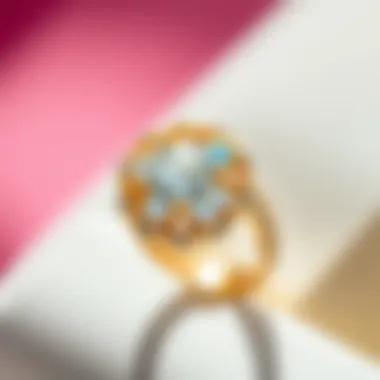
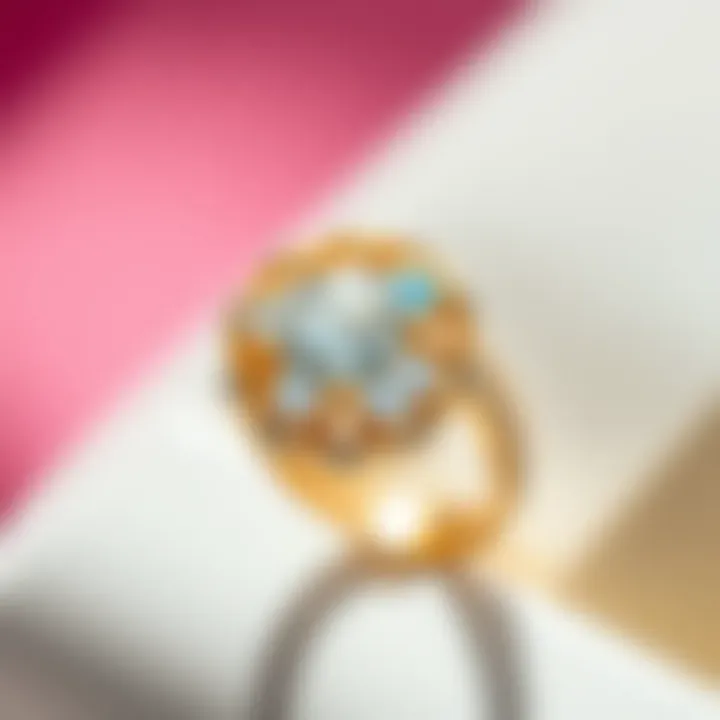
Choosing 10kt gold for an engagement ring involves several compelling reasons.
- Affordability: One of the standout advantages is the cost. 10kt gold rings are generally more budget-friendly compared to their 14kt and 18kt counterparts, making it easier for couples to find a stunning piece without financial strain.
- Durability: As mentioned earlier, the combination of metals in 10kt gold enhances its robustness. This is especially crucial for rings, as they get caught on objects, exposed to hard surfaces, and could be subjected to wear on a daily basis.
- Color Options: The alloy's composition lends to various color finishes. It can come in beautiful hues of yellow, rose, or white gold, enabling the buyer to express personal style in a distinct way. Whether you favor a warm yellow tone or a cool silver finish, there's a 10kt gold option that aligns with your aesthetic desires.
Pros and Cons of 10kt Gold Engagement Rings
When it comes to choosing an engagement ring, one of the first decisions couples face is the type of metal for the band. In this context, 10kt gold ranks among the popular options for a variety of reasons. However, like a two-edged sword, it has its advantages and disadvantages. Understanding the pros and cons relevant to 10kt gold can aid potential buyers in making an informed choice that suits their taste and budget.
Advantages of 10kt Gold
When discussing the benefits of 10kt gold, it’s important to highlight its durability. Being composed of 41.7% pure gold mixed with other metals such as copper or silver, this alloy offers a sturdiness that can withstand daily wear. This is particularly valuable for engagement rings, which are often subjected to the rigors of everyday life.
- Affordability: Compared to higher karat gold options like 14kt or 18kt, 10kt gold comes with a friendlier price tag. This translates to more zeroes in your bank account remaining, even after purchasing a beautiful ring.
- Versatility in Design: The alloying process allows jewelers to create a vast array of designs, from minimalistic to intricate styles. Since it holds its shape well, 10kt gold can be crafted into various styles without compromising quality.
- Hypoallergenic Properties: Those with sensitive skin might benefit from certain 10kt gold mixes that minimize allergic reactions, depending on the metals used in the alloy. This makes it safer for wear.
- Color Variations: The mix also permits different color shades - rose, white, and yellow gold can all be achieved through variations in metals added to the gold. This variety allows for personal expression, making it easier to find a ring that resonates aesthetically.
Potential Drawbacks
Despite its many advantages, 10kt gold is not without its downsides. Some drawbacks may affect your decision significantly.
- Lower Resale Value: When it comes time to part with your engagement ring, you might find that 10kt gold has a lower resale value compared to its higher karat counterparts. The gold content is less, so if you are investing for potential resale, this could be a key element to consider.
- Less Luster: The gold in 10kt is mixed with other metals, causing it to have a less vibrant color and luster than higher karat gold. If a bright, shimmering ring is what you are envisioning, you may find 10kt gold lacking.
- Durability vs. Brittleness: While 10kt gold is indeed more durable, the lower gold percentage can lead to some brittleness, particularly if the ring sustains heavy impact.
- Frequent Maintenance: Rings made from 10kt gold may require more frequent upkeep to maintain their shine and aesthetic appeal. Regular cleaning and polishing might become necessary, adding to long-term care considerations.
Making a decision on the hallmark of your engagement ring requires balancing these pros and cons, weighing personal preferences against practical considerations as well.
Design Considerations
When thinking about engagement rings, the design isn't just a matter of aesthetics; it's about weaving together personal meaning and cultural traditions. In the realm of 10kt gold engagement rings, the design can reflect individuality and taste while considering practical aspects like durability and comfort. Understanding design considerations will help buyers navigate the myriad of choices available, ensuring that the ring not only looks beautiful but also fits seamlessly into the lifestyle of the wearer.
Styles of 10kt Gold Engagement Rings
Engagement rings come in various styles, each echoing different sentiments and aligning with individual preferences. Here are some popular styles worthy of consideration:
- Solitaire: A classic choice, solitaire rings feature a single gemstone, often showcasing the beauty of the stone itself. This simplicity can really shine in 10kt gold, enhancing its warm tones.
- Halo: A ring style that surrounds the center stone with a circle of smaller stones, halo rings sparkles with extra flair. This option can make a solitary gemstone look even larger and more impressive.
- Three-Stone: Symbolizing the past, present, and future, this design includes three stones. The sturdier 10kt gold setting allows for intricate designs while maintaining durability.
- Vintage: Vintage-style rings often incorporate intricate engravings or unique settings that carry historical significance. They allow a touch of nostalgia, which many find appealing.
- Contemporary: Clean lines and minimalism define contemporary designs. They speak to modern taste, appealing to individuals looking for something less traditional.
Choosing the right style is crucial as it reflects not just aesthetic preferences but also the recipient's personality and values.
Customization Options
Customization provides couples the opportunity to create a piece that feels unique and personal. With 10kt gold as a base material, there are several options to explore when it comes to customization:
- Engravings: Adding personalized engravings to the band can make the ring feel even more special. Whether it’s a date, initials, or a significant phrase, engravings can add a personal touch.
- Gemstone Choices: While diamonds are the traditional choice, opting for alternative gemstones such as sapphires, emeralds, or rubies can offer a pop of color and individuality. This flexibility allows the couple to choose stones that hold personal significance.
- Mixed Metals: Some may choose to combine yellow, white, or rose gold in a single design, highlighting individuality and creativity.
- Setting Styles: From prong to bezel settings, the choice of how to set the stone can influence the overall look and feel of the ring. Each style has its pros and cons in terms of security and aesthetics.
Ultimately, these customization options help to craft a ring that serves as a true reflection of the couple's journey together, making it not just a piece of jewelry, but a treasured symbol of commitment.
"Design is the silent ambassador of your brand." - Paul Rand
For further insights and inspiration, consider exploring related resources like Wikipedia and Britannica. This thoughtful approach will certainly result in a ring that stands the test of time, both in style and sentiment.
Gemstone Selection for 10kt Gold Engagement Rings
Selecting the right gemstone for a 10kt gold engagement ring is a dance of personal taste and symbolic meaning. A gemstone isn't merely a rock; it embodies emotions, memories, and significant milestones in a relationship. When adorned on a 10kt gold ring, the choice of gemstone can elevate the piece, adding depth to its beauty. This chapter dives into why gemstone selection matters so much in this context, looking at various factors from styles and colors to durability and personal significance.
Popular Gemstones
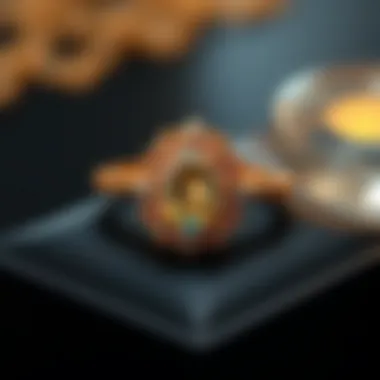
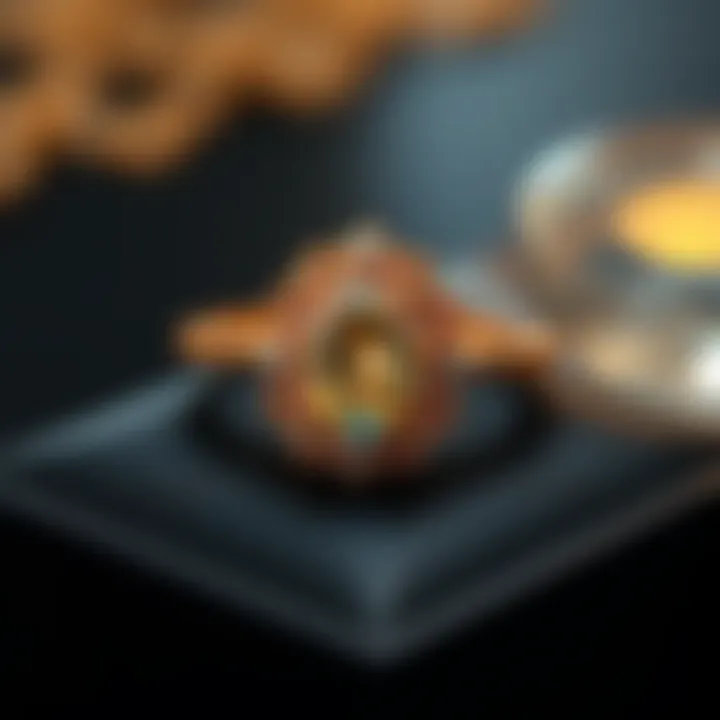
When it comes to choosing a gemstone, several options stand out for their beauty and symbolic meaning. Here are a few popular choices:
- Diamond: A timeless classic, diamonds symbolize eternal love and commitment. Their unbeatable hardness makes them ideal for everyday wear.
- Sapphire: Known for their deep blue color, sapphires also come in a variety of shades. They are durable and symbolize loyalty and nobility.
- Emerald: With their vibrant green hue, emeralds are believed to represent hope and renewal. They are softer than diamonds but bring a unique flair.
- Ruby: The fiery red of rubies represents passion and love. They are durable and can withstand the rigors of daily life.
- Moissanite: A gorgeous alternative to diamonds, moissanite has a brilliant sparkle. It’s often chosen for its ethical sourcing and affordability.
Each gem carries its own allure, so the choice often boils down to personal preference and meaning. Plus, the right gemstone can harmonize beautifully with the color of 10kt gold, vibrant and warm, enhancing its overall appeal.
Sourcing Ethical Gemstones
In today's world, where sustainability is key, sourcing ethical gemstones has taken center stage. Consumers are increasingly considering the implications of their purchases. Here are some important aspects to think about:
- Traceability: Knowing where your gemstone comes from not only assures its quality but also its ethical background. Ethical sourcing means the gemstone is mined responsibly with respect for both nature and communities.
- Certification: Look for gemstones that come with certification from reputable organizations. This documentation verifies the gem's origin and assures that it was mined without conflict. For consumers who value accountability, this is key.
- Lab-Created Stones: Choose lab-created alternatives instead of mined stones. These gems offer the same beauty as natural stones but come with a significantly lower environmental impact.
- Small-scale Artisans: Supporting local artisans who practice ethical mining and gem cutting supports communities while ensuring fair trade practices. It adds a unique touch to the ring, knowing its origins are both ethical and personal.
By focusing on ethical gemstone sourcing, one can marry beauty with responsibility, creating a ring that reflects not just style but also values.
"The choice of gemstone should reflect your unique story, just like the engagement ring itself."
In sum, the gemstone selected for a 10kt gold engagement ring is not just about visual appeal; it embodies the essence of love, commitment, and ethical responsibility. When you pay attention to these factors, you can find a piece that is not just beautiful but also has a story behind it.
Pricing Factors
Understanding the pricing of 10kt gold engagement rings is key for anyone looking to make a significant investment in their love story. The cost hinges on various elements that interplay to create the final value. As you dive into the world of jewelry, you'll want to keep a sharp eye on these factors.
Understanding Cost Composition
When talking about pricing, it's essential to dissect what's included in the cost composition. The primary components can be categorized as follows:
- Gold Content: Simply put, this refers to the amount of actual gold in the ring. 10kt gold is made up of 41.7% pure gold, with the remainder made of other metals. This dilution reduces the price when compared to higher karat gold but still offers durability.
- Design Complexity: Rings with intricate designs or custom features such as engravings or unique settings often come with a higher price tag. The craftsmanship involved adds to the overall cost, and sometimes, it’s these details that make the ring truly special.
- Gemstone Quality: If your engagement ring includes a gemstone, its quality, size, and rarity will significantly influence the price. A round brilliant diamond or a rare color gemstone can push the price upwards due to demand and desirability.
- Brand and Retailer Markup: Different jewelry brands have various pricing strategies, and the same ring might see a price hike based on the brand's reputation and market positioning. Shopping around and comparing similar designs might help in avoiding overpaying.
- Market Demand: Supply and demand dynamics directly affect gold prices. If the gold market is buzzing and demand increases, you might find yourself digging deeper into your pockets.
Understanding these components allows for more informed decisions. It’s about not just finding a ring that looks good, but also understanding what you’re investing in.
Market Trends Affecting Prices
Apart from understanding cost composition, one also needs to stay attuned to the market trends that affect prices. The jewelry market doesn’t operate in a void; various external factors can cause prices to fluctuate:
- Economic Conditions: General economic health plays a significant role. Struggles in the economy can increase demand for precious metals as safe-haven assets, thereby raising prices. Conversely, a booming economy can lower gold prices if consumers shift to spending on other luxury items.
- Gold Market Activity: Gold prices are intricately linked with global market fluctuations. News and events, including geopolitical instability or changes in mining output, can send ripple effects through the price of gold.
- Seasonal Demand: Often, trends show increases in sales during specific times of the year, such as holidays and wedding seasons. This seasonal demand can create brief spikes in prices.
Understanding these market dynamics is not merely an academic exercise; it’s vital for anyone planning a purchase. By identifying patterns and enhancing your awareness, you can better predict when to buy. It might even save you a substantial amount of money.
Keeping an eye on these pricing factors enables buyers to make savvy choices, merging aesthetic appeal with financial sense.
Maintenance and Care
Maintaining and caring for your 10kt gold engagement ring is pivotal for prolonging its beauty and longevity. An engagement ring is often a cherished symbol of love and commitment, representing a significant moment in one’s life. To ensure that this sentimental piece remains in excellent condition, it’s important to understand proper maintenance practices that extend not just to aesthetic upkeep but also to the ring's structural integrity.
Cleaning and Storage Best Practices
Keeping your ring looking as good as new starts with regular cleaning. 10kt gold is durable, but over time, dirt, oil, and grime can tarnish its shine. Here are some effective cleaning methods:
- Gentle Soap Solution: Mixing a few drops of mild dish soap with warm water can do wonders. Soak your ring for about 20-30 minutes, then gently scrub with a soft-bristled toothbrush, focusing on intricate settings where dirt could lurk.
- Ultrasonic Cleaners: For those with a busy schedule, ultrasonic cleaners can provide a thorough clean in minutes. Just be sure to read the instructions carefully to avoid damaging any gemstones.
- Professional Cleanings: Consider having your ring professionally cleaned every couple of years to preserve its brilliance and ensure that all settings are secure. Jewelers have specialized tools and solutions to clean without scratching the gold.
Regarding storage, always store your ring in a dedicated box or pouch lined with soft fabric. Avoid tossing it into your jewelry box where it could scratch against other pieces. Keeping your ring in a separate compartment minimizes risk of damage and helps maintain its presentation.
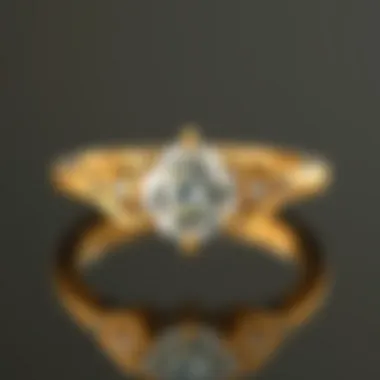
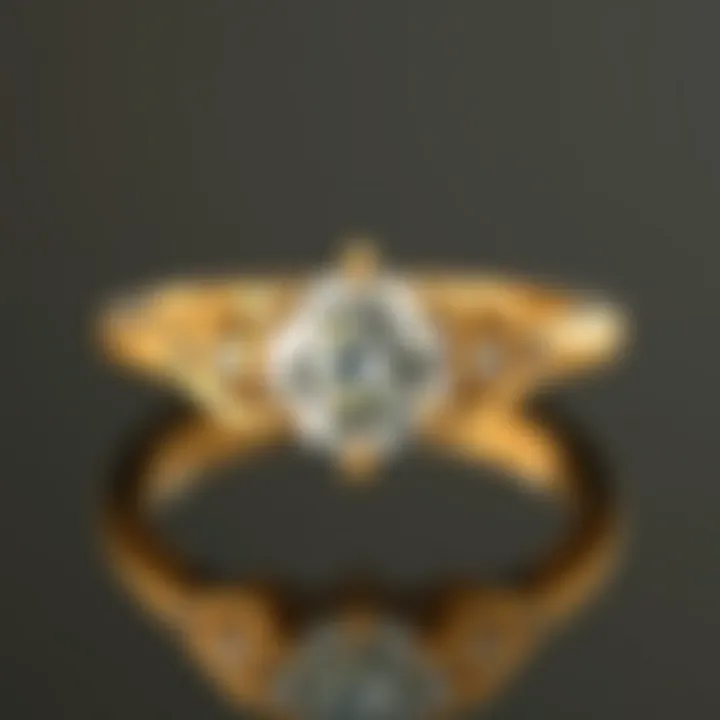
Long-Term Care Tips
Managing the long-term care of your 10kt gold engagement ring requires a little more diligence but is crucial for preserving its emotional and monetary value.
- Avoid Exposure to Harsh Chemicals: Contact with skincare products, cleaning agents, and even chlorine can dull the finish. Be cautious while applying lotions or perfumes, and always remove your ring before engaging in activities like swimming or cleaning.
- Regular Inspections: Take a moment every few months to inspect your ring. Look closely at the stones, prongs, and overall condition. If there are any signs of loosening or scratches, consult a jeweler.
- Protective Measures: When engaging in physical work or activities, it may be a good idea to remove your ring and store it away. This simple act can spare it from unfortunate accidents, like dents or scratches.
"Your ring should reflect the love it symbolizes; regular care keeps that love shining bright."
By adhering to these cleaning and storage best practices, as well as long-term care tips, your 10kt gold engagement ring can withstand the sands of time, maintaining not only its beauty but also its sentimental value for years to come.
Cultural and Historical Perspectives
Engagement rings have always held a special place in human history, acting not only as tokens of love but also as markers of tradition and cultural significance. Understanding the cultural and historical underpinnings of engagement rings, particularly those crafted in 10kt gold, adds layers of meaning to your purchase, making it much more than just a piece of jewelry.
The cultural implications can vary significantly across different societies and epochs. For instance, in many Western cultures, the engagement ring symbolizes a promise of marriage and commitment, solidified by the act of wearing it. In other corners of the world, engagement rings might differ in material or design but still represent similar vows and promises.
The historical journey of engagement rings reflects not just changing tastes in design but also shifts in societal values. Through this section, you will gain a greater appreciation of the weight these rings carry, and how a 10kt gold engagement ring can embody both modern sensibilities and traditional meanings.
Traditional Significance of Engagement Rings
Historically, engagement rings are thought to have originated in Ancient Rome, where a simple band made of iron was worn on the fourth finger of the left hand. Romans believed this finger contained a vein, known as the "vena amoris" or vein of love, that led directly to the heart. This symbolic gesture was a way to signify the bond between two individuals, reflecting their commitment to one another.
Over time, the traditions surrounding engagement rings evolved significantly. The introduction of diamond engagement rings in the 15th century marked a pivotal moment. This shift came about largely due to the marketing initiatives of diamond companies, which successfully positioned diamonds as symbols of enduring love and unbreakable bonds.
In modern contexts, many couples opt for 10kt gold engagement rings due to their unique blend of durability, affordability, and aesthetic appeal. A ring that embodies personal stories, heritage, and even the ups and downs of love becomes a cherished symbol, transcending mere ornamentation.
Evolution of Engagement Ring Styles
As societal norms shifted, so did the styles of engagement rings. When Sarah Jessica Parker wore a stack of rings on "Sex and the City," many couples saw a spike in interest regarding unique, personalized ring styles. From classic solitaires to modern halo settings, the designs that reflect personal tastes are infinitely diverse. Today, it’s common to find engagement rings adorned not just with diamonds but with colored gemstones and intricate designs, showcasing a couple’s personality and preferences.
10kt gold rings have witnessed a growing trend due to their wide range of colors and qualities. From cool white gold to warm yellow and alluring rose gold, they offer versatility that appeals to various tastes. Furthermore, their resistance to tarnishing and scratching provides practicality that complements evolving styles.
As society leans into more expressive forms of love and commitment, the evolution of engagement ring styles mirrors cultural shifts while allowing individuals to articulate their emotional narratives through their choices of rings.
Key Takeaway: 10kt gold engagement rings are not just a product of aesthetic choices; they symbolize a rich history and cultural significance, making each ring an embodiment of personal values and shared experiences.
Through these cultural and historical lenses, the journey of selecting a 10kt gold engagement ring becomes more than just a matter of looks. It becomes a celebration of love, tradition, and individual stories interwoven into the very fabric of its being.
Choosing the Right Ring
Selecting an engagement ring isn’t just about picking something that shines well; it's a decision that carries immense importance, often entwined with emotions, values, and commitments. The choice speaks volumes about love and represents the beginning of a significant journey. With 10kt gold being a popular choice, understanding how to choose the right ring becomes essential.
The process involves considering not only the ring’s aesthetic appeal but also its durability, price point, and the personal tastes of the wearer. Each ring tells a story, and together you want to express a narrative that aligns with your unique relationship. The right ring propels this story forward, establishing a strong foundation for a future together.
Personalized Factors to Consider
When it comes to selecting a 10kt gold engagement ring, personal preferences take center stage. Factors such as individual styles play a crucial role. For instance, a classic solitaire may appeal to a traditionalist, while a contemporary design might excite someone with modern taste. Here are a few points to ponder when choosing:
- Metal Preference: While 10kt gold is great for durability, consider if your partner prefers gold, white gold, or even rose gold. Each has its charm and influence on the overall look of the ring.
- Lifestyle: Think about the lifestyle of the person who will wear the ring. If they're often engaged in activities like sports or hands-on work, a more robust design may suit their needs.
- Stone Shapes and Types: The gemstone is perhaps the heart of the ring. Round diamonds are traditional, while some may prefer unique shapes like pear or oval. Consider the type of gemstone too; diamonds are classic, but sapphires or other stones can add a personal touch.
- Sizing: Practical matters such as sizing shouldn’t be overlooked. Getting the right fit might require stealthy measures such as borrowing a ring they currently wear.
Every detail matters. When you pause to consider each element thoughtfully, the right ring will start taking shape in your mind.
Expert Consultation and Services
If the whole process of choosing the right engagement ring feels overwhelming, you're not alone. Seeking the help of a professional jeweler can take off a bit of the pressure. Expertise can make a difference in how well the selected ring aligns with personal taste and practical needs. Here’s what a reputable jeweler can offer:
- In-depth Knowledge: Jewelers are often well-versed in the materials and styles available. They can help you navigate the nuances of 10kt gold and suggest options you might not have considered.
- Customization Services: If you want something unique, many jewelers provide customization options to bring your exact vision into reality, ensuring the ring is as distinctive as the love it symbolizes.
- Ethical Sourcing: An expert can guide you on ethical practices, ensuring the gemstones come from reputable sources. Whether it’s lab-created stones or ethically sourced diamonds, knowing the backstory can enhance the value of your purchase.
- Insurance and Maintenance Advice: Once you've chosen your perfect ring, an expert can advise on insuring the ring and proper long-term care strategies, helping you preserve the jewelry’s beauty and integrity over the years.
Navigating the world of engagement rings is a journey worth undertaking, and with the right help, you can find a piece that not only dazzles but also resonates with your personal story.







